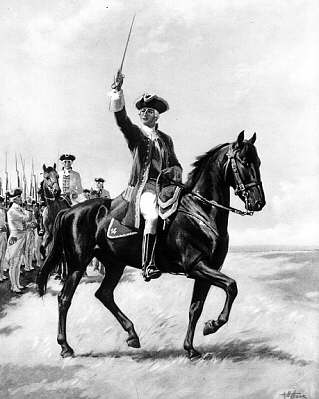 Louis-Joseph, marquis
de Montcalm, seigneur de Saint-Véran, was born on February 29th,
1712 near Nïmes, France. His father was born of Huguenot parents and
was converted to Catholicism by his wife, the Marquise de Saint-Véran.
Montcalm was influenced greatly by his mother.
Louis-Joseph, marquis
de Montcalm, seigneur de Saint-Véran, was born on February 29th,
1712 near Nïmes, France. His father was born of Huguenot parents and
was converted to Catholicism by his wife, the Marquise de Saint-Véran.
Montcalm was influenced greatly by his mother.
Montcalm spent his early childhood with his maternal grandmother at Roquemaure. He had delicate health and at the age of 6 had not yet learned to read due to health problems. His uncle took over his education and Montcalm advanced quickly in his lessons.
He followed the tradition of his family and joined the army at the age of fourteen. He had a special talent as a man of action. As a soldier he continued to study and read profusely.
Montcalm married Angélique-Louis Talon du Boulay in 1736. Her grand uncle had founded the administration in New France, which was Canada. They had 10 children, while only 6 survived - 2 boys and 4 girls. Montcalm was a family man, was strongly attached to his natal village in France, his wife and his children.
His first fighting was in 1733. He fought in the Italian campaign in 1746 where he was injured wounded by 5 saber cuts and was taken prisoner for a time. When he returned to France he was promoted to Brigadier. During a battle in the Alps he was again wounded in a battle where 4,000 French soldiers died. He was congratulated by the king and promoted to "commander" after this expedition. He subsequently had a few years of peace from 1748 to 1756.
He was chosen by the king of France to command the troops in North America and was given the rank of Major-General.
Montcalm was hot-tempered, conceited, always upset over petty slights whether real or imagined. He commanded the French regulars and had systematic direction of the forces in the field. However, the biggest drawback for the French army was divided command. Governor general Vaudreuil was resentful, vain and unsure of himself. The two men clashed often and changed the orders of the other. This division would prove deadly for the French army.
During the siege of Quebec by the English, Montcalm spent many anxious days and nights. He was constantly on the move as the English would feign landings at various sites along the river during early September.
While awaiting an attack by the English, Montcalm wrote to the commander of the French at Lake Champlain that, "I am booted and my horses are saddled, which is in truth my usual way of spending the night. I have not undressed since the twenty-third of June" (Wrong, p. 219).
In the fighting on the Plains of Abraham, Montcalm, on a big black horse, had been prominent in the fight always attempting to rally his forces. As the French were retreating, he was hit in the abdomen. He was able to stay in the saddle and ride into the walled city, but died the next morning of his wound. He remarked that he was happy to die rather than live to see the surrender of Quebec.
The Marquis de Montcalm was buried in the Ursuline chapel inside the walled city. A bombshell had torn up the floor and made a cavity in the soil. This indentation was made larger and Montcalm was buried in this spot.